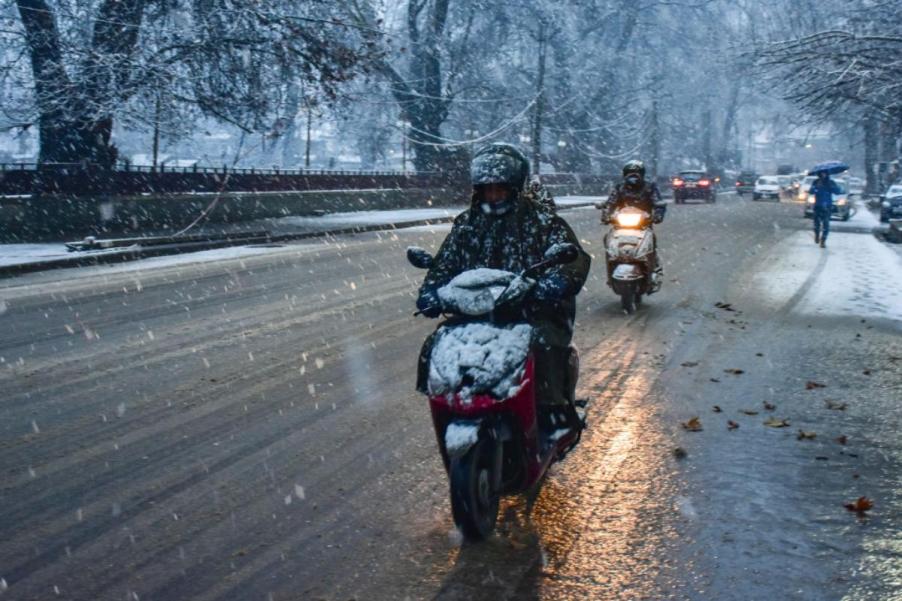
Is It Safe to Ride a Motorcycle During Winter?
Riding a motorcycle in the winter presents some unique challenges unless you’re in an area unaffected by winter weather. For those in colder climates, preparation is vital for safe, year-round motorcycle riding. Let’s consider why and how we should take extra care before riding this winter.
Why is it more dangerous to ride a motorcycle during the winter?
Motorcycle riders accept an elevated degree of danger year round as the price for the exhilaration of riding. Tavss Fletcher says riding a motorcycle in the winter intensifies the risk, even beyond that of car drivers. While motorcyclists share some of winter’s dangers with car drivers, other unique hazards exist.
Of course, everyone on the road in the winter has to deal with potentially slippery roads. Winter in most of the country brings snow, ice, and the aftermath of salt and sand. While these conditions affect those on four wheels, only having two wheels further reduces vehicle stability.
Reduced visibility from snow, fog, and dirty windshields is another hazard shared among winter travelers. With the frequency of automobile drivers turning or pulling out in front of motorcycles because they “didn’t see them” in good weather, winter weather’s reduced visibility only increases the risks. Turning on motorcycle headlights at all times of the day and wearing high-visibility outerwear when riding are easy precautions to take.
Cardo says hypothermia while driving is a winter hazard unique to motorcycle riders. While drivers sit in their warm vehicles sipping hot beverages, motorcycle riders must endure exposure to the elements. Throw a 70 mph wind chill on top of sub-freezing temperatures, and hypothermia can quickly lead to degraded muscle control, confusion, and poor decision-making.
How can motorcycle riders prepare for winter riding?
If you’re just starting to think about owning a motorcycle and how it fits into your winter travel plans, J.D. Power recommends beginning with the right bike.
Dual sport motorcycles, featuring an upright riding position and more aggressive tire tread, are well suited to winter riding. In addition, they usually weigh considerably less than cruisers or sportbikes, a feature you’ll appreciate if you ever happen to tip over.
If you already have a motorcycle you plan to ride in the winter, you should check your anti-freeze strength and inspect your tires. Changing the engine oil to the manufacturer’s recommended cold-temperature weight and type is also a good idea.
Preparation is key to safely riding a motorcycle during the winter. First, if weather predictions call for snow or ice, it’s best to take four-wheeled transportation. But if you have to ride in such conditions, it’s essential to stay calm, slow down, and allow more following distance, just as if driving a car.
The next preparation step is wearing the right gear to avoid hypothermia. Layering is the key to staying warm without feeling restricted. Start with insulating base layers, followed by fleece, and topped off with high-visibility wind and waterproof outer layers.
Wool is a time-tested insulating layer, but avoid cotton articles that wick away warmth when wet. In addition, modern synthetic fabrics and insulation work well. Also, several battery-powered accessories provide additional heat, like gloves, socks, vests, handlebar grips, and motorcycle seats.
The final safety measure is preparing to wait for rescue. Just like in a car, if you get stranded and can’t walk for help, you’ll need to wait, except you’ll be outside. Being stuck out in cold weather is a dangerous situation.
First, charge your cell phone before you leave to call for help when needed if you have cellular service. Depending on where you plan to ride, pack emergency supplies like food, water, and even a small emergency stove to make a hot beverage. Of course, if you can walk to a nearby house or business to seed assistance, do that.
What if I plan to park my bike for the winter?
Family Handyman provides an excellent step-by-step guide to winterizing your motorcycle for storage. The guide includes the following maintenance tips:
- Fill the fuel tank with fresh fuel and add a quality fuel stabilizer
- Change the oil and oil filter
- Fog the engine with fogging oil
- Drain the carburetor
- Change the final drive lube (if equipped)
- Lubricate the drive chain (if equipped) and all pivot points
- Critter-proof air intakes and exhaust pipes
- Install a battery maintainer
- Check anti-freeze strength and level
- Spray the entire bike with a light coating of WD-40
Hopefully, you’ll be able to enjoy your bike throughout the winter. While avoiding the worst of the winter storms is wise, hopefully, there’ll be many days filled with sunshine and relatively warm temperatures. As always, stay safe and happy riding.



